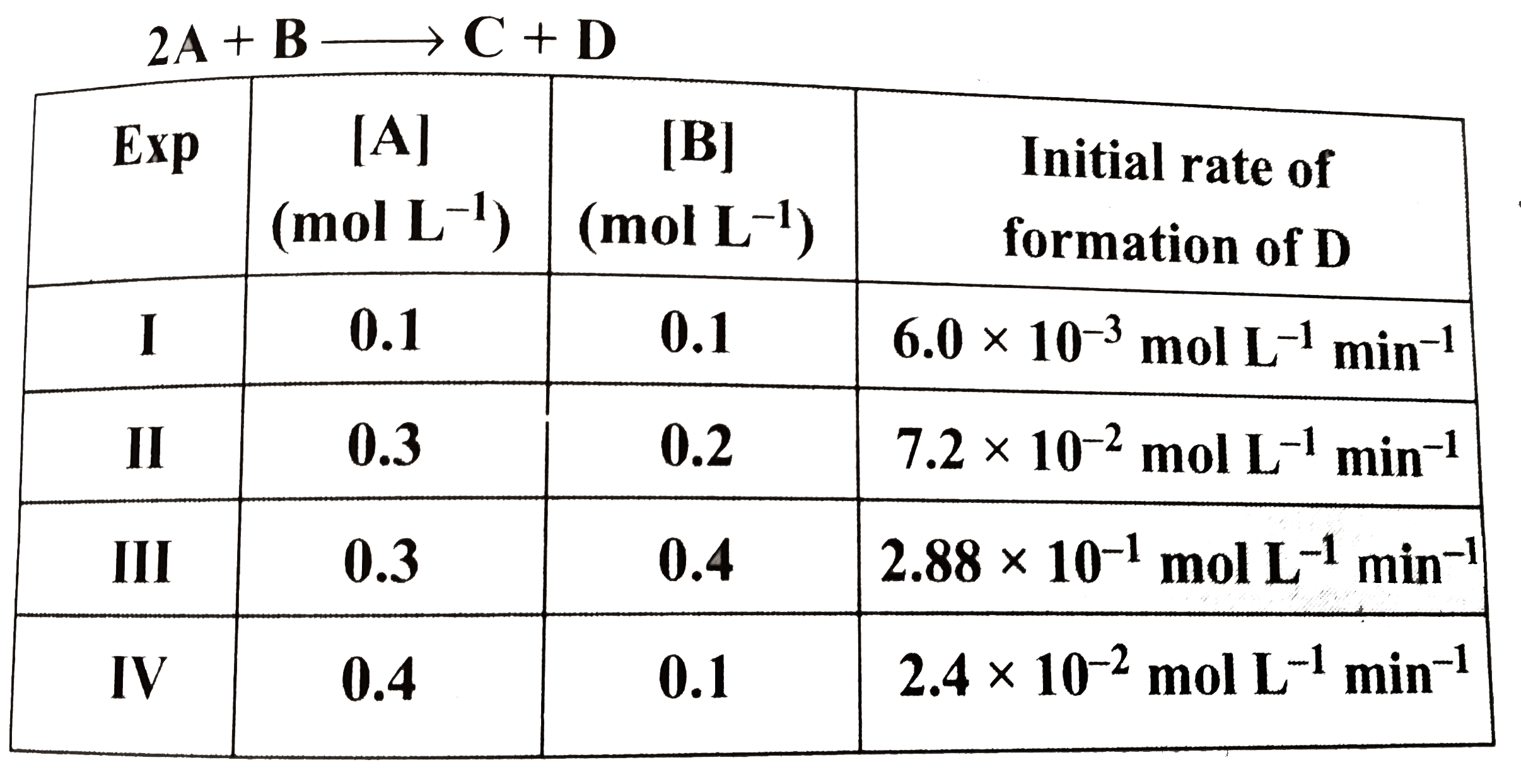The following rate data were obtained at 303 K for the following reaction :
2A+B→C+D

What is the rate law? What is the order with respect to each reactant and the overall order? What are the units of rate constant?
For the given reaction rate =k[A]x[B]Y
After substituting the values of initial rates and initial concentration, the value of x and y can be calculated. Then x + y will give the order of the reaction.
For experiment 1,6×10−3=(0.1)x(0.1)y ...(i)
For experiment II, 7.2×10−2=(0.3)x(0.2)y
For experiment III, 2.88×10−1=(0.3)x(0.4)y
For experiment IV, 2.4×10−2=(0.4)x(0.1)y
Determination of x. In order to get the value of x, divide equation (iv) by (i)
2.4×10−26.0×10−3=(0.4)x(0.1)y(0.1)x(0.1)y,(4)1=(4)x,
∴x=1
Determination of y. In order to get the value of y, divide equation (ii) by (ii).
2.88×10−1)7.2×10−2=(0.3)x(0.4)y(0.3)x(0.2)y,4=(2)y
or (2)2=(2)y∴y=2
Order of reaction with respect to A and B are 1 and 2 respectively.
The over all order of the reaction = 1 + 2 = 3.
∴ Rate law =k[A]1[B]2 [∴x=1,y=2]
units of rate constant . since rate =k[A]1[B]2
∴k= rate [A]1[B]2=6.0×10−3molL−1−min(0.1molL−1)(0.1molL−1)2
=6.0mol−2L+2−min
∴ unit of rate constant ,kismol−2L+2−min
Topper's Solved these Questions
- CHEMICAL KINETICSBOOK - ICSECHAPTER - CHEMICAL KINETICSEXERCISE - PROBLEM
165 Videos
- CHEMICAL KINETICSBOOK - ICSECHAPTER - CHEMICAL KINETICSEXERCISE - INTEXT QUESRTIONS
81 Videos
- BIOMOLECULESBOOK - ICSECHAPTER - BIOMOLECULESEXERCISE - ISC EXAMINATION QUSTIONS (PART-I)(DESCRIPTIVE QUESTIONS)
21 Videos
- CHEMISTRY IN EVERYDAY LIFEBOOK - ICSECHAPTER - CHEMISTRY IN EVERYDAY LIFEEXERCISE - EXERCISE (PART - II (DESCRIPTIVE QUESTIONS) (LONG ANSWER QUESTIONS))
19 Videos
Similar Questions
The following rate data were obtained at 303K for the following reaction:
2A+B→C+D

What is the rate law? What is the order with respect to each reactant and the overall order? Also calculate the rate constant and write its units.
View SolutionThe reaction A+B → C has zero order. What is the rate equation?
View SolutionThe reaction A+B→C has zero order. What is the rate equation?
View SolutionThe reaction A+B→C has zero order. What is the rate equation?
View SolutionWhat are (a) rate law and (b) specific rate ? Write the units of rate constant.
View SolutionThe reaction A+B → C. has zero order. What is the rate equation?
View SolutionThe following rate data were obtained at 300 K for the reaction
2A+B→C+D

Calculate the rate of formation of D when : [A]=0.5 mol L− and [B]=0.2 mol L−
View SolutionThe following rate data were obtained at 300 K for the reaction
2A+B→C+D

Calculate the rate of formation of D when : [A]=0.5 mol L− and [B]=0.2 mol L−
View SolutionThe following rate data were obtained at 300 K for the reaction
2A+B→C+D

Calculate the rate of formation of D when : [A]=0.5 mol L− and [B]=0.2 mol L−
View SolutionWhat is the order of the reaction whose rate constant has the same unit as the rate of reaction ?
View Solution
